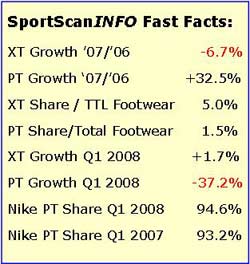Whether consumers or retailers are ready for it, the cross-training category is about to attempt a rebirth. The revival, which is now being heralded by major marketing campaigns touting Under Armours performance trainer introduction, as well as Nikes SPARQ program, will also be supported by renewed efforts by New Balance and Asics. Reebok and Adidas are planning much bigger efforts around training shoes for Spring 2009.
So far, most retailers are overjoyed that the combined marketing muscle of Nike and Under Armour are giving training footwear the most marketing support seen since Nikes “Bo Knows” ads from 20 years ago.
“Anytime in the industry when you have big vendors pushing a technology or a need and higher price points, thats a good thing,” said an exec at a regional sporting goods chain. “If Nike and Under Armour are slugging it out, its only going to make Adidas, New Balance and Reebok say, Weve got to get in that mix or well get left behind, and then they make better product. And the next thing you know, everybodys talking about it and youve got a completely regenerated class in athletic shoes.”
Still, early results based on Nikes SPARQ launch and New Balances offering have not energized consumers to flock to the performance trainer wall just yet. According to retail point-of-sale data compiled by SportScanINFO, the performance trainer category actually declined double-digits in the retail first quarter and Nike share was flat versus last year.
Indeed, vendors believe training has become a bigger opportunity since the Bo Jackson cross trainer, which was built for multi-sport activities. Now, kids are specializing earlier around single-sports and training more as evidenced by the legions of training academies across the country, the growing number of strength and conditioning coaches on teams, as well as the increasing number of performance training accessories at retail. Also, the newer training methods pay more attention to speed, quickness, explosiveness and agility. 
“Our position in performance footwear is, its a piece of equipment,” notes Raphael Peck, SVP of footwear and licensing at Under Armour, which launched its performance trainer over the weekend. “We're using a parachute to improve speed, a box to improve biometrics, or cones to improve your lateral drills. Yet, why do we doing all those drills in running shoes?”
Chris Froio, head of team sports at Reebok, looks forward to using a category outside of running to introduce innovation to the marketplace.
“The training category is an area where you can be super creative,” says Froio. “Weve become a little stale, and thats not for lack of effort or innovation across all brands; its more that running is running, basketball is basketball, and we havent excited the consumer as an industry through the traditional big categories. Cross-training is an area where you can come in with an unexpected and non-traditional approach to the industry and tell a new story to the consumer.”
To some insiders, the biggest opportunity is in re-establishing a market for streetwear shoes in the performance area.
“The battle that Nike and Under Armour are waging right now is around football,” says the exec. “The basketball category has been so weak in terms of sales, and American football is the coolest sport right now. All the cool guys at schools are playing it, but they dont have shoes you can wear as streetwear. So how do you take that football mentality and target that football athlete and turn it into something they can wear around and that you can sell a lot of pairs of?”
And some retailers are privately skeptical about the prospect of turning around what has become a minor presence on shoe walls throughout the country. Making matters worse, the cross-trainer name has become badly maligned. Far from performance, cross-training footwear is now often referred to as “barbecue shoes,” and is largely viewed as bulky white shoes that older men hack around in on the weekend.
According to industry estimates, the cross-training – or barbeque shoe -category is still sizeable, generating about $750 million in sales at retail. The shoes that are actually used for performance training – the area the industry is attempting to revive – is about a third the size.
Retailers are clearly apprehensive about the high price points – between $70 and $110 – that the Nike and Under Armour shoes carry. While consumers will need to be educated about the merits of training shoes, some vendors believe the bigger challenge lies in convincing retailers of the sales opportunity around the category.
“Its the mentality of buyers who are getting hung up on cross-trainers,” says one footwear exec. “Its more about open-to-buy and being open to listen from a retail standpoint. The cross-training bucket has become very stale because it has only been $50 to $60 shoes.”














